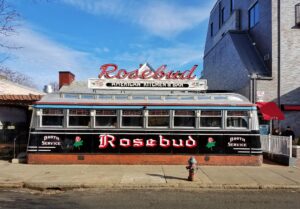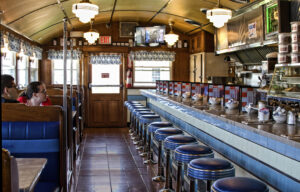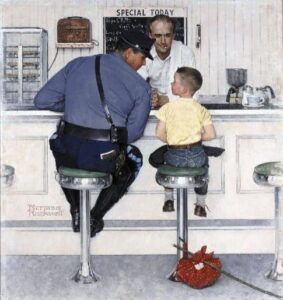By David Wilkening
Contributing Writer

REGION – The next time you get your mashed potatoes with homemade gravy or the “Blue Plate Special” with lima beans made by the cook in the kitchen at your favorite diner, light up a five-cent cigar to celebrate Philip H. Duprey and Grenville Stoddard but add a few puffs for John Francis Hickey Jr. as well.
The five-cent cigar is gone today but it was around when Duprey and Stoddard in Worcester were building a pioneering company that shipped diners all over the Eastern Seaboard.
Taunton draftsman operated famous early diner
Hickey’s famous lunch wagon was a highly prominent and influential early American diner in Taunton, where the slogan for 40 years was “nothing could be finer than to eat in Hickey’s diner.” He was among the figures who made Taunton at one time be termed the ”Lunch Wagon City.” Hickey’s used to sit by the town green, or on Court Street, depending on the time of day, feeding hundreds of hungry people each day. At one point, you could even buy a Hickey’s lunch wagon t-shirt.
After Hickey retired in 1986, the diner was purchased by the city and restored by students at Bristol-Plymouth Regional Technical School, with the goal of bringing it back out for special events, like Taunton’s Christmas parade.
It’s from that point that the story of Hickey’s lunch wagon takes several twists, a sad turn involving a diner museum that never came to be, and ultimately carted off into mystery (so where it went was never determined but it’s no longer serving comfort food).
At one point, Taunton had four lunch wagons, one on each corner of the town green.
The diners were owned by James H. Smith, Arthur T. Brady, Andrew J. Galligan, Timothy F. Mahoney, and Michael J. Behan, according to “Nothing Could Be Finer Than to Eat At Hickey’s Diner,” a 1992 AP English essay written by Hickey descendant Kelsey Koehler. A 19th-century city ordinance allowed these lunch wagons to operate from 4 p.m. until 2 a.m.
Some of them were still horse-drawn as late as 1938.
John Francis Hickey Jr. was born March 4, 1916. He was a 1936 graduate of the Wentworth Institute of Technology, where he trained as an architectural draftsman.
After graduation, he had trouble finding work, but eventually, in 1942, he started working as a counterman at Galligan’s, one of the night lunch wagons.
Two years later, he decided to go into business for himself, buying his own diner in 1944. It was an eight-stool unit, mounted on a 1938 white truck.
Worcester company mass-produced diners

The Worcester Lunch Car Company was, of course, a Worcester-based manufacturer, which operated from 1906 to 1957. During its time, the company produced 651 diners. It was started by Philip H. Duprey and Grenville Stoddard, and they shipped diners all over the Eastern Seaboard. All of its assets were dissolved in 1961.
The diner’s concept in America can be traced to a crude precursor created in 1872 by Walter Scott, who sold food out of a horse-pulled wagon to night employees of the Providence Journal newspaper, in Providence, Rhode Island when restaurants were closed. Scott’s diner can be considered the first diner with walk-up service, as it had windows on each side of the wagon.
Mike Urban, author of “The New England Diner Cookbook: Classic and Creative Recipes From the Finest Roadside Eateries,” provides a realistic portrait of their current state, including healthier recipes emerging from places once known as greasy spoons. He spent two years writing it. “I didn’t feel I was doing a culinary history book as much as just trying to capture this stuff as it’s happening and evolving,” he said.
Urban admitted in interviews that diners are a bit of an endangered species. But television programs such as Guy Fieri’s “Diners, Drive-Ins and Dives” have helped save many of them.
Diners have long been regarded as an “endangered species.” There have often been predictions of their imminent demise. But they carry on and have survived the worst of the pandemic. When carry-out orders were so popular, they were seen as the industry “saviors.”
What exactly is a diner? Definitions vary but the Visiting New England website put it this way:
“Diners are best known for their history, tradition, an extensive menu selection, large portions of comfort foods at fair prices, quick service, oak and mahogany booths, counter with stools, jukeboxes, a stainless-steel exterior, and plenty of neon.” It added that “Not all diners possess all of those elements.”
Clearly, many factors create a true diner but in a nutshell, “diner” is a derivative of “dining car” and “diner designs reflected the styling that manufacturers borrowed from railroad dining cars,” according to the Rhode Island-based American Diner Museum website.
Diners almost always feature a counter, stools and a food preparation or service area along the back wall, states the American Diner Museum, which by the way, “consider(s) every diner to be a living museum.”
Always on the menu: comfort food
At their most basic, diners offer what is known as “comfort food.” These are hearty dishes which promote a feeling of satisfaction and are often associated with childhood or home cooking. Think meatloaf, mac and cheese, corned beef hash and eggs, and pancakes with butter and maple syrup.

“The Runaway”, Norman Rockwell, 1958. Cover illustration for The Saturday Evening Post, September 20, 1958. From the permanent collection of Norman Rockwell Museum.
Photo/courtesy Norman Rockwell Museum
If you don’t believe diners have symbolized America, look at what the movies have done with them. Hollywood has romanticized the American diner in films such as “Diner” “and “Grease.” And in television shows like “Seinfeld.”
Closer to home here, artists have been part of the wave. One example: Norman Rockwell’s famed 1948 painting “The Runaway,” which portrayed a young boy and a caring highway patrolman. You can guess where they met. They were sitting at the counter of Joe’s Diner in Lee.
RELATED CONTENT:
Grafton man recalls posing for iconic Norman Rockwell painting (fiftyplusadvocate.com)












